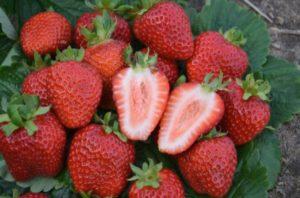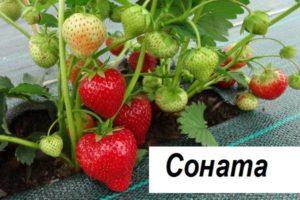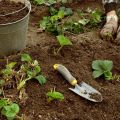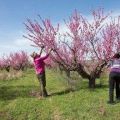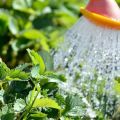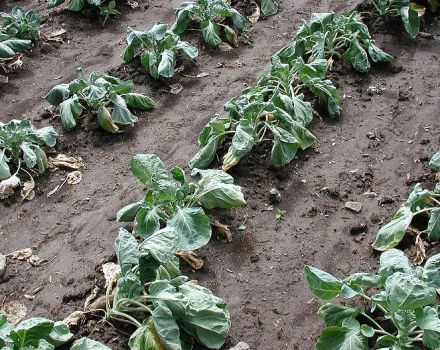When and how to properly trim strawberries, timing and step-by-step instructions
Garden strawberries are considered the most common berry. One aspect of caring for a plant is pruning. To know when to trim the whiskers and leaves of strawberries, you need to figure out which variety the plant belongs to. For example, remontant varieties have almost no whiskers, and only leaves are required to be trimmed.
Do you need to cut the leaves of the strawberries?
Whether or not to cut off strawberry leaves for the winter is up to each summer resident to decide on his own. Pruning foliage has significant advantages, but there are also disadvantages. If you cut the deciduous part in the fall, the nutrients will only go to the root. In the spring, this will have a beneficial effect on the growth of bushes.
When the plant is pruned
The timing of pruning depends on what exactly is going to be cut from the strawberry. The mustache is removed in the middle of summer. They begin to grow after flowering, but the first few weeks the mustache is small and it is undesirable to touch them during this period. It is recommended to wait until they grow up.
Also, in late autumn, if there are any, you should not touch them. The foliage is pruned before the onset of frost. In the summer, even after harvesting, the foliage is not touched.
When pruning strawberries, it is best to focus not on the calendar, but on the age of the leaves. Trim foliage as it ages. The leaves begin to turn yellow gradually, over about two weeks. When the leaves become completely yellow and covered with red spots, they begin to cut them. This usually happens towards the end of July. After the procedure, the bushes have time to become covered with new green leaves until autumn.
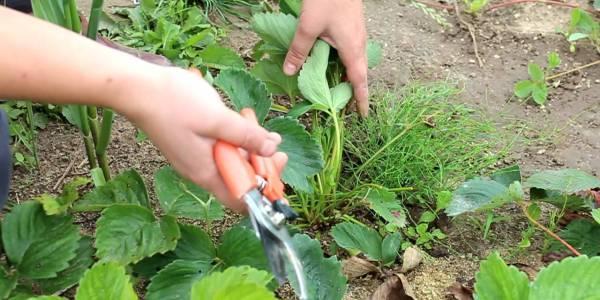
Pros and cons of autumn pruning
Benefits of pruning strawberry leaves in the garden in autumn:
- The main advantage of cutting the deciduous part is that nutrients go only to the root. The root system becomes powerful and developed, which helps the strawberries survive frosty winters.
- Many gardeners are of the opinion that frost resistance increases. The statement, of course, is controversial, but suddenly it really becomes easier for strawberries to endure frosts.
- Together with the cut foliage, pests are destroyed, which often remain on the foliage until late autumn.
The disadvantages include the following points:
- Together with the leaves, the buds are cut off in the fall, which bear fruit in the spring, the buds of the strawberries are laid in the fall, and in the spring they grow. If you cut off all the leaves, there will be yield problems next year.
- When pruning, pests and fungal spores fall to the ground, spreading diseases around the site.
- Strawberries grow longer in spring.
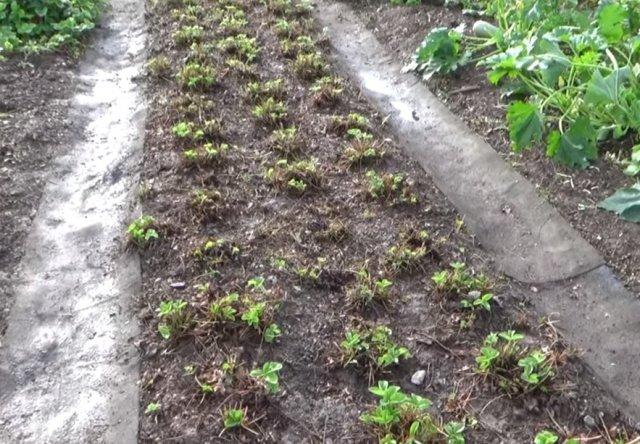
Despite the advantages, cutting leaves in the fall has significant disadvantages that cannot be ignored. For example, it is not recommended to cut a mustache from strawberries at all, this has a bad effect on productivity.
Advantages and Disadvantages of Spring Pruning
Some summer residents cut the ground part of the strawberry in the spring. The advantages of the procedure in the spring are:
- Together with old leaves, they destroy pests that hibernated in the bushes and larvae.
- Nutrients from the soil only reach the root system, it grows strong and healthy.
- With the timely removal of the whiskers, nutrients and moisture only enter the mother plant and berries. The yield increases.
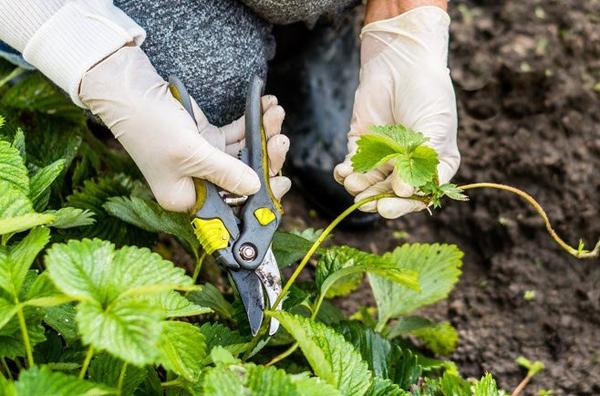
The disadvantages include the following factors:
- Spores and pests can enter the soil during the procedure.
- If you do not know what the fruit buds look like, they can be cut along with the foliage.
- The bushes will take some time to regrow, so the fruiting times in this case will shift.
The procedure is carried out in the spring in the last days of April.
Advantages and disadvantages of summer pruning
In summer, garden strawberries are cut at the end of July. The benefits of pruning strawberries in summer:
- In the summer, the mustache is cut, the leaves are left until autumn. This allows nutrients from the soil to only enter the mother plants.
- Whisker pruning in August rejuvenates mature plants.
Summer cut has no drawbacks, since during the procedure they get rid of only unnecessary mustache on strawberries. Summer pruning dates are late July - early August.
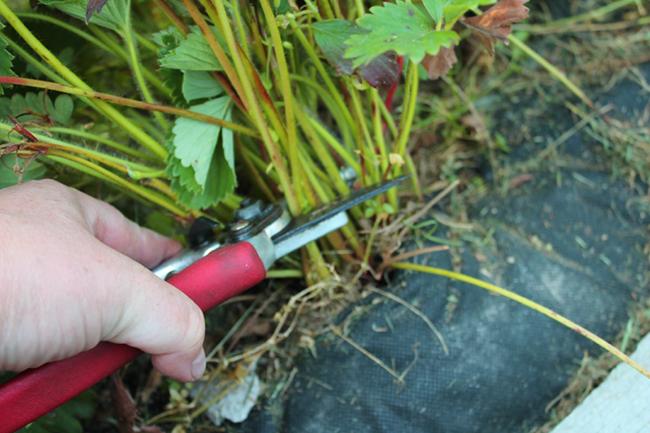
Pruning tools
The procedure does not require a lot of tools. What is needed to cut foliage from garden strawberries:
- sharp garden shears or pruning shears;
- rake;
- newspaper or thick cloth.
During the procedure, a newspaper is laid out next to the bush. This will allow the spores of fungi and insects to crumble on the newspaper, and not on the soil (if they are on strawberries). Then the newspaper is burned, and pests and diseases are not spread throughout the site. A rake is needed to quickly collect cut foliage. Blunt pruners or pruning shears are not suitable. An unsharpened blade will damage the bushes, which will have a negative effect on the health of the strawberries.

Many gardeners prefer to pull off foliage and mustache because it is faster than fiddling with garden shears. But you shouldn't do that. When cut off, the bush is injured and grows poorly in the future.
How to prune strawberry bushes
Pruning is carried out according to a special scheme. Before the procedure, you need to study which parts of the plant belong to fruit buds, so as not to accidentally cut them off.
Pruning leaves
In the spring, the leaves are removed along with the rosettes. As soon as the outside temperature is above zero, the mulching material is removed from the garden and the bushes are examined. Then diseased and dry leaves are cut off. The foliage can only be cut correctly with a sharp sector, so it must be sharpened before the procedure.
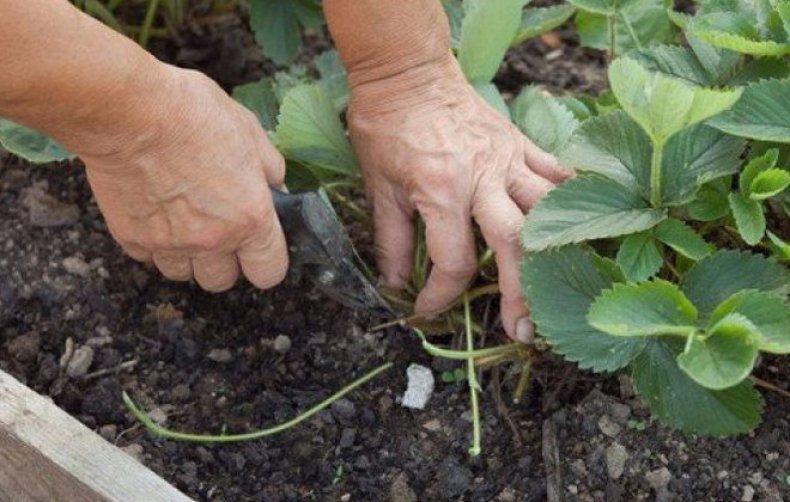
Prune foliage in summer after harvest. If the berries are still unripe on the strawberries, then the pruning will have to be postponed for several days until they ripen. When pruning in spring, the foliage is not cut off completely, leaving petioles 5-8 cm long. You do not need to be too zealous in this matter, especially in spring. If you cut off the entire leafy part at the root, the strawberries will spend all their strength on the growth of new foliage, and not on the formation of ovaries.
The sequence of the procedure:
- Damaged, dry and diseased leaves are cut off. Frozen stems are torn off by hand, as they are very brittle.
- Then all the deformed leaves are cut off. They not only spoil the appearance of the entire bush, but also obscure the sun's rays to inflorescences and berries.
At the end of the procedure, the soil is loosened and weeds are removed. The more oxygen there is in the soil, the sweeter and larger the berries will grow in summer.When the pruning is completed, the cut leaves are raked from the site and burned. Such a measure is necessary for prophylaxis if fungal spores or eggs and insect larvae remain on the foliage.
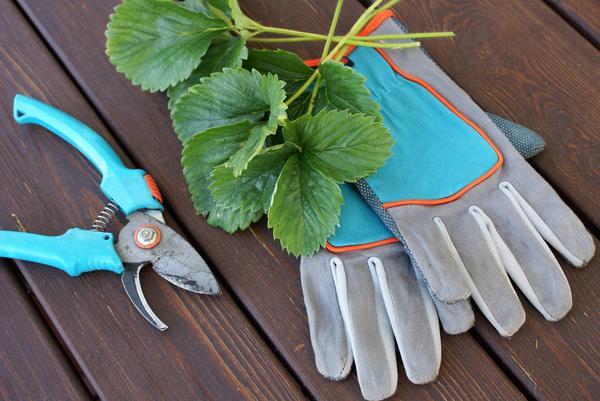
During autumn pruning, most of the strawberry foliage is cut. Only large healthy leaves are left. Everything else is removed, especially if there are spots, dry leaves or insect marks. The cut leafy part is also burned.
Autumn pruning is considered the most traumatic for strawberries. Many summer residents prefer to cut the deciduous part at the root before winter. And this leads to the fact that strawberries tolerate winter harder and grow worse in spring.
Mustache trimming
Pruning is done with a sharp pruner or garden shears. Tearing off the mustache with your hands is not recommended. Outdoors, pruning is done on a dry, sunny day. 5-7 cm are measured from the mother bush, then the mustache is cut off. Gently pull it out of the soil. If the soil is dense, the soil is loosened near the outlets to make it easier to pull the mustache out of the ground.
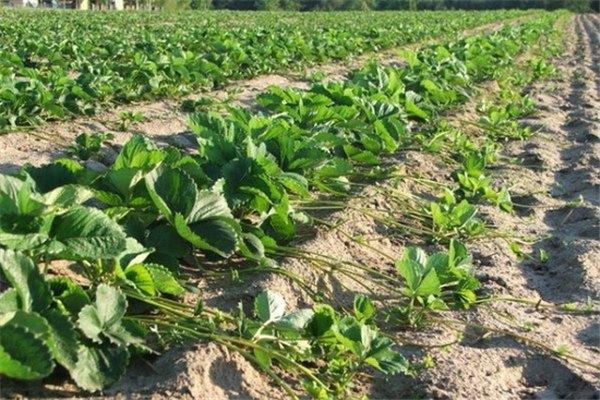
Features of pruning remontant varieties
Pruning remontant strawberries is virtually indistinguishable from conventional varieties. Repaired varieties differ from the usual ones in that they bear fruit twice a year. We'll have to wait until the strawberries finish bearing fruit a second time, and only after that start pruning. It is held approximately in mid-August. Sick, damaged leaves and all yellowed foliage are also cut off. Then the mustache is removed. The cut foliage is burned away from the strawberry beds.
In principle, remontant strawberries can not be cut off at all, so as not to violate the terms of fruiting. Moreover, those varieties that yield more than twice a year, or grow in a greenhouse. Yellow and damaged leaves in such varieties are removed as soon as they appear.
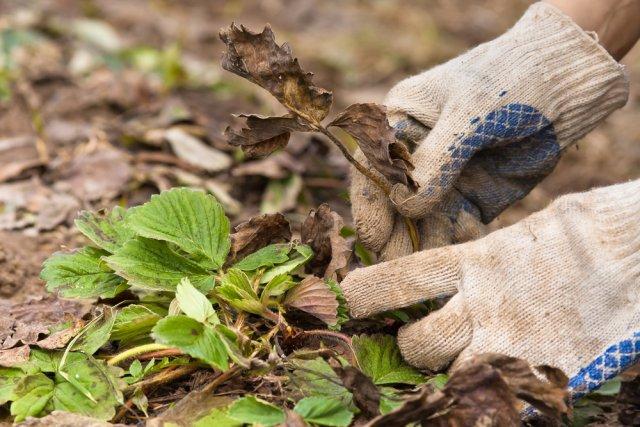
The only thing that will definitely have to be cut on remontant varieties is late flower stalks. The berries will not grow on them anyway, and the nutrients in them go away without getting into the root system, which needs it more in the fall.
Processing and feeding after pruning
After pruning the bushes, strawberries are most vulnerable, therefore, during this period, the plant needs increased care. After the procedure, the bushes are treated with folk remedies. Store drugs are more aggressive. For spraying, decoctions of chamomile, a solution of hydrogen peroxide or iodine are suitable. 2-3 drops of iodine are mixed with 3 liters of warm water and water the beds with the resulting solution. Peroxide is diluted in the same way in warm water and irrigated along with the leaves.

The types of fertilization applied depend on the season in which the strawberries were cut. If garden strawberries were cut in the spring, then fertilizing is applied several times a month. In this case, they are aimed not only at maintaining the bushes, but also at increasing fruiting.
For example, nitrogen, rotted manure, chicken manure or wood ash are used.
In the event that the procedure took place in the fall, the bushes are fed less often and in smaller quantities. Autumn dressing should be aimed at preparing the bushes for winter. Superphosphate or organic fertilizers are added to the soil. When pruning in the summer, feeding is optional, only if the bush after the procedure began to grow poorly. In this case, it can be additionally fed with complex mineral fertilizers.
